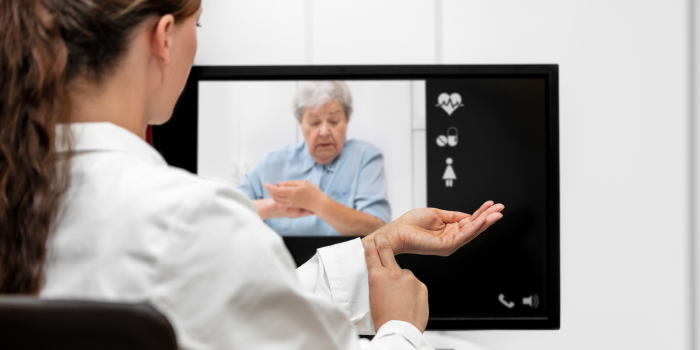6 Reasons Healthcare Providers Love Telemedicine
Healthcare providers love telemedicine for various reasons related to their practice and ensure that they continue to honor their sworn duty to...

The COVID-19 pandemic poses a serious threat to healthcare providers and patients. Telehealth services offer ways to mitigate these safety concerns. Healthcare providers need to offer telehealth services to address the increasing patient demand.
With an ever-increasing concern for safety amidst the COVID-19 public health emergency, healthcare providers like you need to offer telehealth services more than ever.
Health leaders and the federal government have the same view over the matter. Both encourage the widespread adoption of telehealth. They urge more healthcare providers (HCP) to respond as telehealth becomes increasingly essential.
An MGMA (Medical Group Management Association) poll conducted in 2020 with 1,553 respondents shows that 97% of healthcare leaders report their practice has expanded telehealth access amid COVID-19.
With more than a million active physicians in the US and more patients participating in virtual health clinics, we need more HCPs joining the huddle.
Telehealth is the delivery of health care services virtually or at a distance using technology. It uses electronic information and telecommunication tools allowing you to provide healthcare even when you and your patients aren’t in the same place.
It includes conducting medical visits online, monitoring patients' vital signs, and diagnosing and treating disease with tools such as videoconferencing, remote patient monitoring software, store-and-forward imaging, and streaming media.
The following telehealth methods allow communication between HCPs and patients to deliver health care:
Other types of telehealth include:
Using technology to deliver health care offers advantages such as optimized services and operations and cost-efficient and time-saving patient engagements.
Some of the immediate practical benefits you can't afford to miss include:
The Centers for Disease Control and Prevention (CDC) recognizes the public health mitigation strategies telehealth services offer via its remote setup, increasing compliance to social distancing during this pandemic.
Telehealth services are safer for both HCPs and patients as they reduce potential infectious exposure.
Telehealth also eases the strain on healthcare systems as it minimizes the surge of patient demand on facilities and reduces PPE use.
These efficiencies and cost-saving changes provide an expected result of transitioning in-person visits, treatments, and other health-related appointments to a virtual setup.
In the context of a pandemic or any other similar predicament, telehealth services can help you avoid further negative effects from delayed preventive, chronic, or routine maintenance care.
Remote access to healthcare increases participation for medically or socially vulnerable patients or those who lack ready access to providers. It also helps sustain the continuity of patient-provider relationships when an in-person visit is not practical or feasible.
One thing that has kept some HCPs and insurance payers from patronizing telehealth services is the out-of-pocket costs it might require.
However, many insurance payers and HCP professional associations have supported the transition to telehealth services during the COVID-19 public health emergency.
In 2020, the Centers for Medicare & Medicaid Services (CMS) began paying for a wide range of telehealth services in response to the PHE, including:
CMS has also finalized the addition of these services to the Medicare telehealth list, which will remain covered after the 2021 calendar year ends:
CMS also temporarily added some services to the Medicare telehealth list that will remain through the calendar year in which the COVID-19 crisis ends.
With the Medicare Advantage plan's flexibility, CMS enforces discretion to expand its coverage of telehealth services during the pandemic.
However, Medicare Advantage plans must cover all telehealth services under Medicare fee-for-service.
Meanwhile, commercial health plans have likewise broadened coverage for telehealth services at this time, and probably in the foreseeable future. Most of them cover some types of telehealth services.
As COVID-19 cases continue to rise and its effects on patients and their families worsen, HCPs will witness an increased demand for telehealth services as an effective tool for healthcare management. It will also continue to be the more practical option for patients seeking medical attention.
Health leaders also foresee this increase even beyond the pandemic. HCPs and patients' experiences of the benefits and advantages of telehealth reveal its potential in improving healthcare quality regardless of a pandemic.
Telehealth has opened more opportunities for specialists to enhance the technology for better outpatient online visits and outcomes.
It has also empowered patients to prefer desired healthcare providers regardless of their physical limitations, location, or prevailing situation.
The CDC has also proposed to increase HCPs' uptake of telehealth service by implementing the following measures.
Telehealth offers so much more for you and your patients that you will not regret offering it now.
Even before the Covid pandemic, the health care landscape was changing to optimize care operations to improve the efficiency, efficacy, and service quality of primary health care providers.
The change is a result of the cost-constrained health care delivery system. This undercurrent coincides with another phenomenon where more individuals increasingly favor an active role in designing their own lives - the shift from provider-centered care to a patient-centric approach.
The present health care system is designed primarily from the provider's perspective.
The outcome of this changing landscape is a redefinition of the patient-doctor relationship where providers no longer treat patients as passive receivers of health care. Instead, they treat patients as active participants who work as partners with them (participatory medicine). The collaboration aims to optimize health care.
This brewing evolution in healthcare can only be satisfied by a technological advancement that facilitates both organizational optimization and patient-centered care.
The entry of optimized healthcare services and a collaborative and patient-centered healthcare model came when finance and marketing industries were also gearing towards consumer-centered business models.
This shift led to technological developments to support patient-focused services and remote communications. Even so, widespread adoption of this model was relatively slow before the pandemic began.
Telehealth services became a necessary means of providing care, minimizing transmission risk of the SARS-Cov2 that causes COVID-19 to healthcare personnel and patients. The transition to telehealth had to be fast-tracked.
The immediate and compelling reasons for this acceleration include minimizing exposure, preserving personal protective equipment, and minimizing the impact of patient surges on facilities.
Healthcare providers and administrators adjusted all aspects of care, including triage, evaluation, treatment, and billing, for patients using methods that don’t rely on in-person services.
According to CDC, policy changes during the pandemic have reduced the barriers to telehealth access. These changes have promoted the use of telehealth as a way to deliver acute, chronic, primary, and specialty care.
Many professional medical societies endorse telehealth services and guide medical practice in this evolving landscape.
Telehealth services allow patients to access healthcare providers from almost any part of the country. HCPs can choose to participate in patient case management in remote rural areas. However, interstate licensure challenges and other regulatory issues vary by state.
Telehealth cannot replace in-person visits, which are sometimes more appropriate due to urgency, underlying health conditions, or inability to perform an adequate physical exam remotely.
Telehealth may not be effective in situations where discomfort or privacy is a concern. Doctors’ appointments often involve sensitive topics, which can create uncertainty when patients don't fully trust even HIPAA-compliant platforms.
The most apparent telehealth limitation is its dependence on basic technological requirements such as devices (e.g., computer, tablet, smartphone) and connectivity for virtual medical visits to work, as millions of Americans don’t have access to reliable internet services.
Given its limitations and that this might be a new setup for most HCPs, it is crucial to get acquainted with a few things to protect you and your telehealth services.
You must understand individual federal and state regulations, their restrictions, temporary mandates and directives, and expiration dates when offering telehealth services.
It benefits your telehealth service to monitor updated regulatory actions for healthcare systems and HCP.
Operating regional systems that provide services in multiple states requires you to be attentive to individual state requirements.
You should track eligibility criteria based on their specific profession and maintain awareness of the Office for Civil Rights (OCR) announcements related to HIPAA and COVID-19.
It pays to put extra effort into training providers and staff on policies, practices, and protocols for using telehealth services. Training is necessary even if the following tasks are familiar simply because there will be changes in the modality: referral processes for specialty care, urgent and emergent care, laboratory services, pharmacy prescriptions, medical equipment, follow-up visits, appointment scheduling, documentation, and billing.
The pandemic has brought the healthcare system to its most challenging times. But as with every crisis, new opportunities arise. The way we offer patient care will never be the same again. Telehealth is going to be part of the healthcare system's "new normal."

Healthcare providers love telemedicine for various reasons related to their practice and ensure that they continue to honor their sworn duty to...

The COVID-19 pandemic changed how many industries manage their day-to-day operations, healthcare included. With lockdowns that prevented people from...

Medicare is a federal health insurance program in the United States that facilitates medical care by providing health insurance to people over 65...